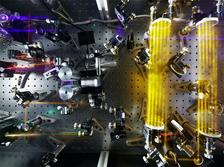Previous version of the optical setup used at DESY (Photo: DESY, Heiner Müller-Elsner).
An international team of scientists from DESY, the University of Hamburg and the Massachusetts Institute of Technology in Cambridge (USA) has achieved the direct generation of isolated attosecond pulses, i.e. pulses with duration in the order of 10-18 seconds. This was possible thanks to a novel laser source providing finely controlled optical field waveforms which allows tuning the produced attosecond pulse properties, such as photon energy, spectrum and temporal duration. The results appeared in the journal Nature Communications.
The novel laser source employed in this experiment is called parametric waveform synthesizer (PWS). In the PWS, two few-cycle infrared pulses are combined in space and time to form a sub-optical-cycle pulse, and their relative phase and delay can be finely controlled. This means that not only the general shape of the pulses in time, its envelope, but also their detailed temporal structure (electro-magnetic field or optical field) can be controlled within a single oscillation of the field.
The research team focused the laser pulses from the PWS into a noble gas target inside a vacuum chamber. Thereby, they generated isolated attosecond pulses via the process of high harmonic generation (HHG). In HHG, electrons are first separated from their atom due to the strong laser field. Then, the same field accelerates them for a time, corresponding to the duration of a single field oscillation (optical cycle), and the electrons acquire energy during the acceleration. Finally, when atoms and electrons recombine, the gained energy can be emitted in form of X-ray photons which constitute the attosecond pulses. Generally, the laser field driving the process contains few to several optical cycles. The HHG process occurs repeatedly for every optical cycle of the driver field, therefore generating multiple pulses besides the central one (non-isolated pulses). In this work, due to the sub-cycle duration of the laser field, the attosecond pulses were isolated which means there were no so-called pre- and post-pulses. Such well-isolated pulses allow for improved temporal resolution and contrast in follow-on time-resolved attosecond spectroscopic experiments. In addition, the possibility to control the phase between the infrared pulses allows for strong modulation of the generated spectra, as shown in the figures below.
The new source will be a "workhorse" for attosecond science which is devoted to the observation of the ultrafast motion of electrons in atoms and molecules in gas, liquid and solid phase. Up to now, attosecond science has been strongly limited by the reduced tunability of the pulse properties needed for a specific experiment. With the new findings, it will be possible to customise the laser pulses to the requirements of the system under investigation.
In addition, slight modifications of the present apparatus will allow for the generation of pulses in a spectral range, the so-called water-window region (282-533 eV). This region is of extreme interest for chemists and biologists because water is transparent to the radiation of this energy-range but not carbon, the main building-block of biological samples. Therefore, it will be possible to observe samples of molecular and biological systems in their natural water environment and at their natural time scale.
Reference
Strong-field Coherent Control of Isolated Attosecond Pulse Generation; Y. Yang, R. E. Mainz, G. M. Rossi, F. Scheiba, M. A. Silva-Toledo, P. D. Keathley, G. Cirmi, and F. X. Kärtner, Nature Communications (2021), DOI: 10.1038/s41467-021-26772-0









